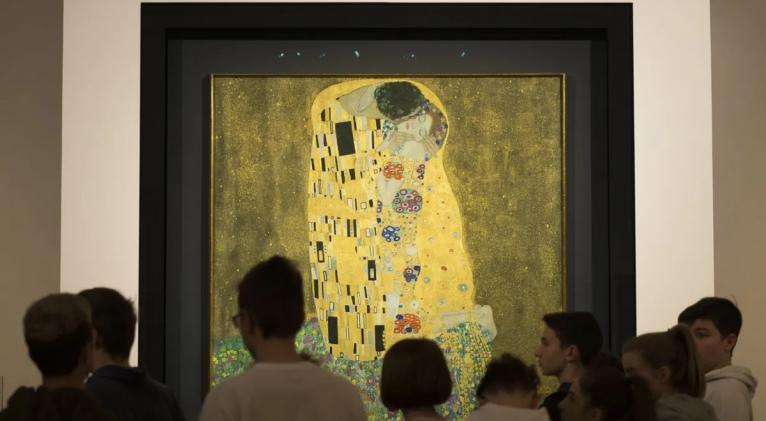Klimt’s The Kiss
especiales

In the world of art, many art works recreate that intimate moment of the kiss of love. And whenever I see this painting by Austrian painter Gustav Klimt I wonder how he felt. I try to picture in my mind what intense tenderness led him to recreate that scene full of sweetness and sensuality in a spring field.
This painting, which is more than a century old, shocked me as soon as I saw it. Firstly, for the range of colors used, for the details of little flowers, stars and other figures, for its simplified composition, but, above all, for the complicity that I sense, and for the calm expression of the girl who not only allows herself to be kissed, but embraces her lover—I want to believe that's the case—without wanting him to go away, just like lovers.
It manages to catch the attention of the masses. And why? Because it is an allegory of love, because, in fact, this feeling is the only power that keep us alive. It is not by chance that it is the Austrian's best-known piece, because the public feels its essence.
The Kiss is a masterpiece of Viennese symbolism. Klimt also treasures others of great artistic value, but this one is surrounded by an unusual mystique that even non-expert individuals like me can identity. The interpretations may vary, some related to Greek mythology and the moment in which Apollo kisses nymph Daphne. However, Klimt never explained its meaning.
It is currently exhibited at the Belvedere Gallery, Vienna, Austria. It was conceived at the beginning of the modern era, when the concept of eroticism also began to be used both in art and in society. It is a large oil painting on canvas, almost two square meters, which stands out for its luminous background and those yellow and ocher tones that draw my attention so much. It also has other shiny elements that range from gold to silver, and a certain Asian flair can be distinguished.
The Kiss is the most significant part of Klimt's so-called “golden stage,” in which he experimented with laminate techniques that gave him vividness and distinction, and which turned out to be an innovation for European art nouveau.
The lovers are merged into a single figure, dressed in tunics that are also too striking for their time, highly decorated with contrasting mosaics and arabesques, without a concrete background, as if they and that portion of grass were floating, suspended in nothingness, where, with all certainty, we go under the effect of love when we kiss, when little by little the contours and the sounds blur and we are only left with our sensations.
For me it is a metaphor, a universal statement about the emotions in our lives. I find it hypnotic, powerful and delicate at the same time. It is what I feel when I watch it. It transports me. I am self-absorbed. That is why I do not understand that part of the criticism that attributes violence and machismo to the supposed dominant position of man, as if we forget that in such an occasion of ardor there can also be impulse and frenzy, madness and urgencies.
No matter how much I dig into the art piece, I do not find dark meanings in it. And when I ask questions about the girl's disposition, I only discover a pleased, welcoming stance, and hugging arms. I do not understand any repulsive attitude on her part, on the contrary. If she felt outraged and was rejecting him, she should at least be frowning, looking upset, she would not be circling him and caressing his neck and her hand.
It is true that he holds her head, but who doesn't? Sometimes the act of kissing is pure rapture. We want to merge with the other, squeeze them, feel their skin, and everything that is within our reach, from their hair to the soles of their feet. Kissing is feeling alive, there are no protocols. What's more, according to my subjectivity, Klimt's lovers are extremely cuddly, in a peaceful, ornamental background, which inspires me with nothing but softness and affection.
Luckily there is not much of that criterion, which seems to me to be an attack on the author, on the painting. And it is normal in art, as in life, to understand from our perspectives and knowledge, to search for meaning in everything, when, not infrequently, artists create for the sole pleasure of conceiving beauty, and not to vent off their thoughts. Not everything should have a conceptual intention, perhaps it is just aesthetic.
Klimt was a daring painter, considered perverted and scandalous because of the eroticism present in his works. He was even rejected and called a pornographer. Without a doubt, a misunderstood for his time. But he, knowing that it is impossible to please everyone, did not renounce his style, and always found acceptance in a sector capable of valuing art without so much far-fetched interpretation.
His professional career gained prestige over the years until he became an icon of the Belle Époque. He is still known today as the painter of beauty and passion, recognized for his special interest in the female nude. But a century ago, these freedoms were a moral problem, hence the anger, debates, and scandals.
Fortunately, his art prevailed and he left us works like The Kiss, and many more. The Kiss gained popular clamor, probably not because of the mythological recreation involved, perhaps because of the skill demonstrated, but, above all—even without knowing Klimt's intention—because of the message of sensitivity and romanticism this couple conveys, as if time and space did not exist under the power of a kiss. Who does not feel identified with it?
Translated by Sergio A. Paneque Díaz / CubaSí Translation Staff














Add new comment